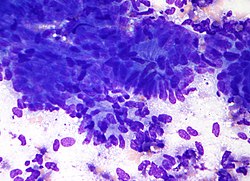Difference between revisions of "Adenocarcinoma"
Jump to navigation
Jump to search


| (8 intermediate revisions by the same user not shown) | |||
| Line 1: | Line 1: | ||
[[Image:Lung adenocarcinoma - pleural fluid -- very high mag.jpg|thumb|right|250px|Adenocarcinoma (lung). Pleural fluid specimen. [[Pap stain]]. (WC)]] | |||
[[Image:Colorectal adenocarcinoma cytology low mag.jpg|thumb|right|250px|Adenocarcinoma (colorectal). [[Field stain]]. (WC)]] | |||
[[Image:Colorectal adenocarcinoma -- high mag.jpg|thumb|right|250px|[[Colorectal adenocarcinoma]]. [[H&E stain]]. (WC)]] | |||
'''Adenocarcinoma''' is a form of [[cancer]] that arises from glandular tissue. Adenocarcinoma can arise in many sites. | '''Adenocarcinoma''' is a form of [[cancer]] that arises from glandular tissue. Adenocarcinoma can arise in many sites. | ||
| Line 5: | Line 8: | ||
=Types of adenocarcinoma= | =Types of adenocarcinoma= | ||
==Site specific== | ==Site specific== | ||
Below is an incomplete list of adenocarcinomas. | |||
===Gastrointestinal pathology=== | ===Gastrointestinal pathology=== | ||
====Esophagus==== | ====Esophagus==== | ||
| Line 75: | Line 79: | ||
DDx: | DDx: | ||
*Carcinoma (poorly differentiated). | *Carcinoma (poorly differentiated). | ||
*[[Sarcoma]], esp. [[epithelioid | *[[Sarcoma]], esp. [[epithelioid sarcomas]]. | ||
*Benign glands. | *Benign glands. | ||
**[[Endometriosis]]. | **[[Endometriosis]]. | ||
| Line 82: | Line 86: | ||
===Grading=== | ===Grading=== | ||
Special grading systems exists based on the primary site: | |||
*[[Nottingham grade]] for [[invasive breast cancer]] | |||
*[[Prostate cancer grading|WHO grade groups]] for [[prostate cancer]]. | |||
*Others. | |||
Adenocarcinomas are often graded by their glandular component:<ref>URL: [http://www.cap.org/apps/docs/committees/cancer/cancer_protocols/2011/Esophagus_11protocol.pdf http://www.cap.org/apps/docs/committees/cancer/cancer_protocols/2011/Esophagus_11protocol.pdf]. Accessed on: 6 April 2012.</ref> | Adenocarcinomas are often graded by their glandular component:<ref>URL: [http://www.cap.org/apps/docs/committees/cancer/cancer_protocols/2011/Esophagus_11protocol.pdf http://www.cap.org/apps/docs/committees/cancer/cancer_protocols/2011/Esophagus_11protocol.pdf]. Accessed on: 6 April 2012.</ref> | ||
*Grade 1: >95% of tumour glandular. | *Grade 1: >95% of tumour glandular. | ||
| Line 88: | Line 97: | ||
=See also= | =See also= | ||
*[[Carcinoma]]. | |||
*[[Adenocarcinoma in situ]]. | *[[Adenocarcinoma in situ]]. | ||
*[[Pathologic fracture]]. | *[[Pathologic fracture]]. | ||
Latest revision as of 14:44, 8 November 2019

Adenocarcinoma (lung). Pleural fluid specimen. Pap stain. (WC)

Adenocarcinoma (colorectal). Field stain. (WC)
Adenocarcinoma is a form of cancer that arises from glandular tissue. Adenocarcinoma can arise in many sites.
Adenocarcinoma not otherwise specified, also adenocarcinoma NOS, is a non-specific malignant diagnosis that without further information is not very useful for treatment decisions.
Types of adenocarcinoma
Site specific
Below is an incomplete list of adenocarcinomas.
Gastrointestinal pathology
Esophagus
Stomach
Duodenum
Ampulla of Vater
Pancreas
Gallbladder
Colon and rectum
Other
Lung
Salivary gland
Gynecologic pathology
Ovary
Endometrium
Cervix
- Endocervical adenocarcinoma.
- Villoglandular adenocarcinoma of the cervix.
- Minimal deviation adenocarcinoma of the uterine cervix.
Genitourinary pathology
Prostate
- Prostatic adenocarcinoma, not otherwise specified.
- Prostatic ductal adenocarcinoma.
- PIN-like prostatic ductal adenocarcinoma.
Testis
Urinary bladder
General type
Microscopic (generic)
Features:
- Gland forming - round/ovoid/tubular spaces.
- Eccentric nucleus.
- Moderate cytoplasm +/- vacuoles.
- +/-Prominent nucleolus.
- +/-Nuclear atypia - dependent on type/site.
DDx:
- Carcinoma (poorly differentiated).
- Sarcoma, esp. epithelioid sarcomas.
- Benign glands.
Grading
Special grading systems exists based on the primary site:
- Nottingham grade for invasive breast cancer
- WHO grade groups for prostate cancer.
- Others.
Adenocarcinomas are often graded by their glandular component:[1]
- Grade 1: >95% of tumour glandular.
- Grade 2: 50-95% of tumour glandular.
- Grade 3: <50% of tumour glandular.
See also
References
- ↑ URL: http://www.cap.org/apps/docs/committees/cancer/cancer_protocols/2011/Esophagus_11protocol.pdf. Accessed on: 6 April 2012.
